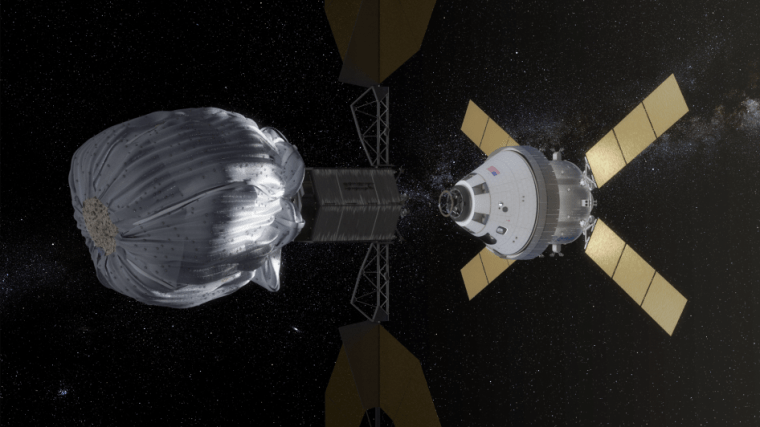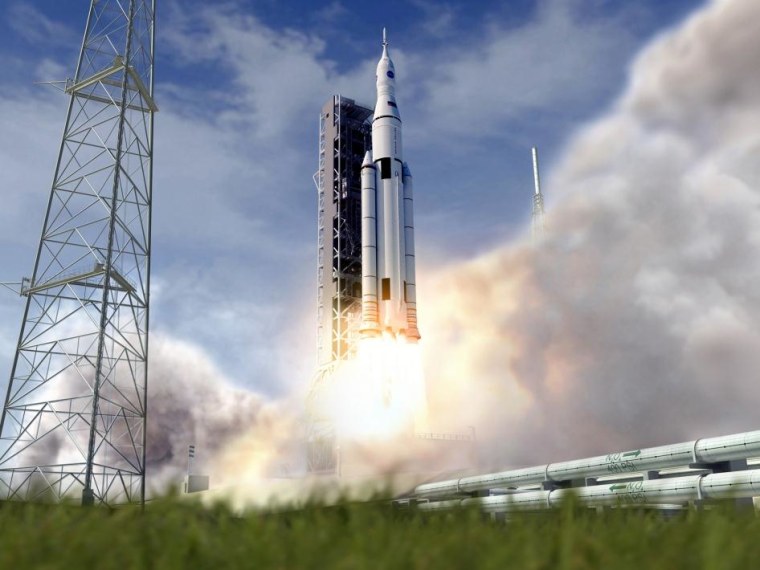CAPE CANAVERAL, Fla. - The federal spending bill signed into law by President Barack Obama on Friday finally picks up the pieces from an initiative that set NASA on a course beyond Earth orbit a decade earlier — a program called Constellation.
Back in 2004, President George W. Bush set the wheels in motion for Project Constellation, at the same time that he set the stage for the completion of the International Space Station and the retirement of the space shuttle fleet.
Constellation would have given NASA two sets of rockets suitable for a wide range of missions, with emergency abort systems and safety measures that the space shuttles never had. These rockets, known as Ares 1 and Ares 5, could have taken astronauts anywhere in our solar system. Constellation offered the quickest route to keep NASA's astronauts flying, and would send them beyond Earth orbit for the first time since 1972.
The station was finished and the shuttles were retired — but the follow-on Ares rocket program was canceled.
NASA was forced to buy seats on Russia’s Soyuz spacecraft to keep the International Space Station staffed. Meanwhile, three years of infighting and knock-down, drag-out arguments failed to build a better mousetrap for going beyond Earth orbit.
Neil Armstrong, who became the first man to walk on the moon in 1969, had this to say in 2010 when he testified before Congress:
"The lunar vicinity is an exceptional location to learn about traveling to more distant places. Largely removed from Earth gravity and Earth’s magnetosphere, it provides many of the challenges of flying far from Earth. ..."Flying in the lunar vicinity would typically provide low radiation exposure than those expected in interplanetary flight. The long communication delays to destinations beyond the moon mandate new techniques and procedure for spacecraft operations. Mission Control cannot provide a Mars crew their normal helpful advice (while landing) if the time delay of the radar, communications and telemetry back to Earth are minutes away."Flight experience at lunar distances can provide valuable insights into practical solutions for handling such challenges. I am persuaded that a return to the moon would be the most productive path to expanding the human presence in the solar system."
Those who had tossed out Constellation hurried back to retrieve pieces of the plan from Washington's waste dump. In 2011, at the direction of Congress, NASA reinstated the big heavy-lift rocket. It's called the Space Launch System, or SLS for short.
'A big win'NASA fared well in the $1.1 trillion omnibus spending bill that wascleared by Congress on Thursday. The legislation includes funding for the agency’s major space and science initiatives, including a crewed mission to Mars by the 2030s. That mission would be sent out on the Space Launch System.
"This is a big win," said Sen. Bill Nelson, D-Fla., who chairs the Senate subcommittee that handles space policy.
NASA officials voiced their pleasure as well. "The bill keeps NASA’s deep-space exploration program on track and will continue to spur American innovation and keep the U.S. the world leader in space exploration," said David Weaver, NASA’s associate administrator for communications.
Here's the bottom line: NASA’s Space Launch System will be the world’s most powerful rocket, capable of flying many kinds of deep-space missions. It can help keep our planet safe through missions to redirect asteroids or anything else that's headed our way.
Not only will it boost astronauts to a multitude of destinations in our solar system, it will be capable of carrying huge scientific spacecraft and telescopes to the far reaches of our solar system.
To do all these tasks, the SLS will be outfitted with a multipurpose crew vehicle called Orion.
Plans for deep spaceIt all gets under way this September at Cape Canaveral Air Force Station in Florida. A United Launch Alliance Delta 4 rocket will boost the first uncrewed Orion to an altitude of 3,600 miles. The test spacecraft will then head back at 20,000 mph. Its heat shield will serve as the protective armor against re-entry temperatures that can reach 4,000 degrees Fahrenheit (2,200 degrees Celsius).
The speed will match that of an Orion craft returning from deep space — almost an exact duplication of the fiery re-entries that were experienced by Armstrong and the other Apollo astronauts.
The performance of Orion during its first heat shield test will tell NASA if the ship is ready for deep-space journeys.

If it is, in 2017 Orion will be placed atop the first SLS heavy-lift rocket — still without a crew — and head out beyond the moon and back. The spacecraft will shoot for a stable lunar orbit, 40,000 miles above the moon's surface. NASA wants to use a robotic probe to redirect an asteroid into that type of parking orbit as early as 2021. Then the space agency would send astronauts to the asteroid in an Orion capsule, to study the object and bring back some of its treasures.
It will be the beginning of a new and exciting time. More important, it will be another step needed for humans to leave their cradle on Earth — to learn about our celestial neighborhood, and to learn about traveling to more distant places.
NBC News correspondent Jay Barbree is the only journalist to cover every spaceflight flown by astronauts from Cape Canaveral. "Neil Armstrong: A Life of Flight," Barbree's book about the first to walk on a place other than Earth, is due for release in July.
